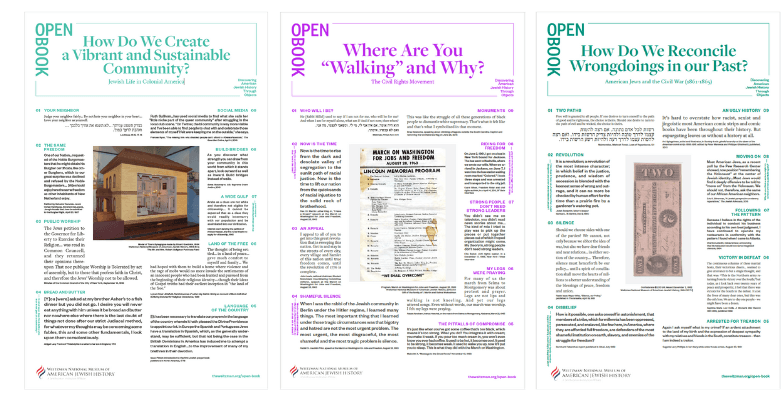Download our national curriculum OpenBook: Discovering American Jewish History Through Objects to teach American Jewish history through objects and partner learning!

Download our national curriculum OpenBook: Discovering American Jewish History Through Objects to teach American Jewish history through objects and partner learning!
The Weitzman National Museum of American Jewish of History is pleased to offer OpenBook: Discovering American Jewish History Through Objects. Based on material culture from the Museum’s collection, the lessons in this national curriculum challenge students to exercise critical thinking and inquiry-based learning skills while exploring the American Jewish experience. In the spirit of traditional Talmudic study, OpenBook invites students to approach the study of history in unexpected ways and connect what they learn to their own ideas, experiences, and passions. This open-ended process of discussion and discovery empowers students to see themselves in the larger story of American Jewish life and inspire a sense of pride and connection to their heritage.
Have questions about OpenBook? Want to stay updated on new lessons?
Let us know! Please email education@theweitzman.org.
We offer teacher professional development on using OpenBook. Interested?
Learn more about our National Educators Institute
Enjoying the lessons? Have ideas on how we can improve?
Click here to take our OpenBook Evaluation Survey.
Each lesson download contains a Talmud Page, Teacher Guide, and Student Guide
What does religious liberty mean and why is it important? Focusing on the Museum’s historic statue, Religious Liberty, this lesson explores the ideal, history, and limits of religious liberty in the United States.
Download “Religious Liberty” Lesson
How do we create a vibrant and sustainable community? In this lesson, students explore the lives and experiences of Jewish immigrants who strove to create a new home — and a new American Jewish identity — in an unfamiliar land.
Download “Colonial Life” Lesson
How do we reconcile wrongdoings in our past? Through Jewish support for the Confederacy this lesson asks students to address times when American Jews have been on what we now consider to be the wrong side of history.
When have you been a “stranger”? Discuss the era mass migration around the turn of the 20th century, when more than two million Jews came to the United States, in context of our contemporary immigrations and your students’ own experiences.
Why do people unite? This lesson focuses on the development of the Jewish labor movement and encourage students to consider the relationship between individualism and political organizing in history and in our lives today.
Download “Labor Movement” Lesson
What does patriotism mean to you? The dramatic events of World War I unleashed forces of xenophobia and nativism that brought about fundamental changes in American attitudes toward immigrants that reverberated throughout the world and are still present in our lives today.
How do I respond to a crisis? This lesson examines the choices and barriers American Jews faced as they confronted the devastation of war and the systemic murder of European Jewry.
Where are you “walking” and why? This lesson explores Jewish involvement in the Civil Rights movement as well as the parallels and differences it unveiled in African Americans and Jews understandings of their experiences with persecution.
Download “Civil Rights” Lesson
Developed in conjunction with our smash hit exhibition, Leonard Bernstein: The Power of Music, this lesson explores music as a means to express hope, mourn, and serve as a force for change through the life of Leonard Bernstein and other musicians.
Are we responsible for others? Students learn about one of the most successful human rights campaigns in recent history while considering their own abilities to create positive change in the world.